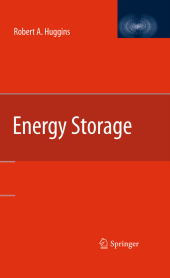 Neuerscheinungen 2014Stand: 2020-02-01 |
Schnellsuche
ISBN/Stichwort/Autor
|
Herderstraße 10
10625 Berlin
Tel.: 030 315 714 16
Fax 030 315 714 14
info@buchspektrum.de |

Robert A. Huggins
Energy Storage
2010. 2014. xxviii, 406 S. 35 Tabellen. 235 mm
Verlag/Jahr: SPRINGER, BERLIN; SPRINGER US; SPRINGER 2014
ISBN: 1-489-99031-3 (1489990313)
Neue ISBN: 978-1-489-99031-0 (9781489990310)
Preis und Lieferzeit: Bitte klicken
This reference is a comprehensive overview of energy storage concepts, methodologies and applications. It explores underlying energy storage fundamentals, discusses important energy storage types, as well as covers various types of batteries.
Introduction Energy is necessary for a number of reasons, the most basic and obvious involve the preparation of food and the provision of heat to make life comfortable, or at least, bearable. Subsequently, a wide range of technological uses of energy have emerged and been developed, so that the availability of energy has become a central issue in society. The easiest way to acquire useful energy is to simply ?nd it as wood or a hydrocarbon fossil fuel in nature. But it has often been found to be advantageous to convert what is simply available in nature into more useful forms, and the processing and conversion of raw materials, especially petrochemicals have become a very large industry. Wood Wood has been used to provide heat for a great many years. In some cases, it can be acquired as needed by foraging, or cutting, followed by simple collection. When it is abundant there is relatively little need for it to be stored. However, many societies have found it desirable to collect more wood than is immediately needed during warm periods during the year, and to store it up for use in the winter, when the needs are greater, or its collection is not so convenient. One can still see this in some locations, such as the more remote communities in the Alps, for example. One might think of this as the oldest and simplest example of energy storage.
General Concepts.- Thermal Energy Storage.- Reversible Chemical Reactions.- Energy Storage in Organic Fuels.- Mechanical Energy Storage.- Electromagnetic Energy Storage.- Hydrogen Storage.- to Electrochemical Energy Storage.- Principles Determining the Voltages and Capacities of Electrochemical Cells.- Binary Electrodes Under Equilibrium or Near-Equilibrium Conditions.- Ternary Electrodes Under Equilibrium or Near-Equilibrium Conditions.- Insertion Reaction Electrodes.- Electrode Reactions that Deviate from Complete Equilibrium.- Lead-Acid Batteries.- Negative Electrodes in Other Rechargeable Aqueous Systems.- Positive Electrodes in Other Aqueous Systems.- Negative Electrodes in Lithium Systems.- Positive Electrodes in Lithium Systems.- Primary, Nonrechargeable Batteries.- Energy Storage for Medium-to-Large Scale Applications.- A Look to the Future.
Aus den Rezensionen:
"... Es schließen sich 22 Kapitel mit theoretischen Grundlagen und verschiedenen Energiespeichermöglichkeiten an. ... das Buch sehr schon die reversible Interkalation ... hilft dem Leser dabei, die verschiedenen Konzepte ... zu verstehen. ... Das lehrreiche und didaktisch gut gemachte Buch bietet einen umfassenden Überblick über die physikalischen, elektrochemischen und strukturellen Prinzipien ... wendet sich gleichermaßen an Studenten Doktoranden wie an Hochschul und Industriewissenschaftler. ... Zielt auf Grundlagenverständnis und eignet sich zum Selbststudium oder auch als Nachschlagewerk ..." (Thomas Wohrle, in: Nachrichten aus der Chemie, April/2011, Vol. 59, Issue 04, S. 469)


